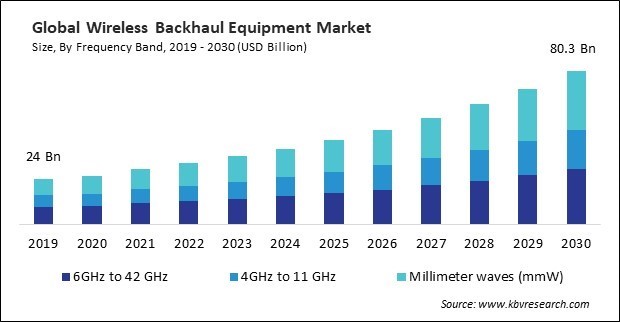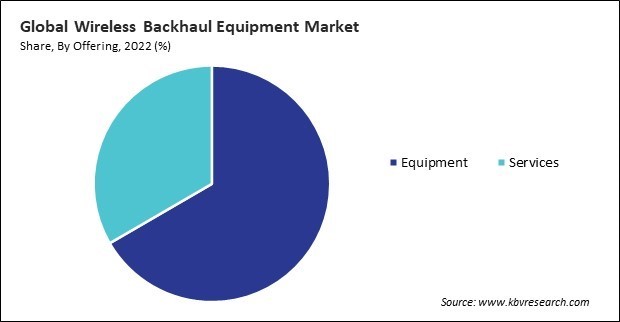“Global Wireless Backhaul Equipment Market to reach a market value of USD 80.3 Billion by 2030 growing at a CAGR of 12.3%”
The Global Wireless Backhaul Equipment Market size is expected to reach $80.3 billion by 2030, rising at a market growth of 12.3% CAGR during the forecast period.
The proliferation of IoT devices in healthcare, such as wearables, medical sensors, and connected medical equipment, requires robust and reliable connectivity. Therefore, the healthcare segment captured $4,941.6 million revenue in the market in 2022. Wireless backhaul solutions play a crucial role in supporting the connectivity needs of these devices, ensuring continuous data transmission for monitoring and analysis. These factors will lead to increased growth in the segment.

The widespread use of smartphones, tablets, and other connected devices has increased data traffic exponentially. Users expect high-speed and reliable connectivity for video streaming, social media, online gaming, and other data-intensive applications. Smartphones have become ubiquitous and are increasingly used for a wide range of activities requiring data connectivity. The adoption of smartphones, particularly in emerging markets, contributes significantly to the surge in mobile data consumption. The development and popularity of various mobile applications contribute to increased data usage. Additionally, the evolution from 3G to 4G LTE and now to 5G is driven by the need for higher data speeds and capacity. Each generation increases data traffic, with 5G promising even greater throughput and data transfer capabilities. This heightened data traffic requires a backhaul infrastructure that efficiently handles the increased load. 5G networks emphasize ultra-low latency, a crucial factor for applications like augmented reality, virtual reality, autonomous vehicles, and other real-time services. Therefore, these factors will help expand the market.
However, the radio frequency spectrum is finite, and different frequency bands are allocated for various wireless communication purposes. In some regions, the available spectrum for wireless backhaul may be limited due to high demand from various wireless services such as mobile communication, broadcasting, and other applications. Limited spectrum availability can lead to congestion in frequency bands used for wireless backhaul. When multiple wireless backhaul systems or other services operate in the same frequency range, interference becomes a concern. Interference can degrade signal quality and impact the reliability and performance of wireless backhaul links. Thus, these aspects will decrease demand in the market.
On the basis of frequency band, the market is divided into 4GHz to 11 GHz, 6GHz to 42 GHz, and millimeter waves (mmW). The 6GHz to 42 GHz segment recorded the maximum revenue share in the market in 2022. The 6GHz to 42GHz frequency band offers higher data transfer rates than lower frequency bands. As the demand for high-speed data transmission and low-latency connectivity increased, particularly with the advent of 5G networks, the market saw a growing preference for solutions operating in this frequency range. Thus, the segment will witness increased growth in the coming years.
Based on offering, the market is bifurcated into equipment and services. In 2022, the services segment garnered a significant revenue share in the market. As operators seek to tailor their networks to specific requirements, there is a growing demand for customized solutions. Service providers play a crucial role in understanding the unique needs of operators and offering tailored services, such as customized network designs, to optimize performance and efficiency. Therefore, the segment will expand rapidly in the coming years.

Based on industry, the market is divided into telecommunications, healthcare, government & defense, commercial, transportation & logistics, and others. In 2022, the telecommunications segment witnessed a substantial revenue share in the market. Telecom operators are adopting network densification strategies to enhance coverage and capacity, especially in urban areas. This involves deploying a higher density of small cells and base stations. Wireless backhaul equipment connects these distributed network elements, ensuring seamless communication and data transfer. Therefore, the segment will expand rapidly in the upcoming years.
Free Valuable Insights: Global Wireless Backhaul Equipment Market size to reach USD 80.3 Billion by 2030
By region, the market is segmented into North America, Europe, Asia Pacific, and LAMEA. In 2022, the Asia Pacific segment acquired the highest revenue share in the market. The Asia Pacific region has witnessed a rapid expansion of mobile connectivity, with a large and growing population adopting smartphones and other connected devices. This surge in mobile users has driven the demand for robust wireless backhaul infrastructure to support increased data traffic. These aspects will boost the demand in the segment.
| Report Attribute | Details |
|---|---|
| Market size value in 2022 | USD 32.1 Billion |
| Market size forecast in 2030 | USD 80.3 Billion |
| Base Year | 2022 |
| Historical Period | 2019 to 2021 |
| Forecast Period | 2023 to 2030 |
| Revenue Growth Rate | CAGR of 12.3% from 2023 to 2030 |
| Number of Pages | 239 |
| Number of Tables | 370 |
| Report coverage | Market Trends, Revenue Estimation and Forecast, Segmentation Analysis, Regional and Country Breakdown, Porter’s 5 Forces Analysis, Company Profiling, Companies Strategic Developments, SWOT Analysis, Winning Imperatives |
| Segments covered | Frequency Band, Offering, Industry, Region |
| Country scope |
|
| Companies Included | Cisco Systems, Inc., Qualcomm Incorporated, Huawei Technologies Co., Ltd. (Huawei Investment & Holding Co., Ltd.), ZTE Corporation, Juniper Networks, Inc., Ericsson AB, RADWIN, Qorvo, Inc., SIA Mikrotīkls, Fujitsu Limited |
By Frequency Band
By Offering
By Industry
By Geography
This Market size is expected to reach $80.3 billion by 2030.
Deployment of 4G LTE and transition to 5G are driving the Market in coming years, however, Spectrum constraints and interference issues restraints the growth of the Market.
Cisco Systems, Inc., Qualcomm Incorporated, Huawei Technologies Co., Ltd. (Huawei Investment & Holding Co., Ltd.), ZTE Corporation, Juniper Networks, Inc., Ericsson AB, RADWIN, Qorvo, Inc., SIA Mikrot?kls, Fujitsu Limited
The expected CAGR of this Market is 12.3% from 2023 to 2030.
The Equipment segment is generating highest revenue in the Market, By Offering in 2022; thereby, achieving a market value of $50.3 billion by 2030.
The Asia Pacific region dominated the Market, By Region in 2022, and would continue to be a dominant market till 2030; thereby, achieving a market value of $30.9 billion by 2030.
Our team of dedicated experts can provide you with attractive expansion opportunities for your business.

 Drivers
Drivers
 Restraints
Restraints
